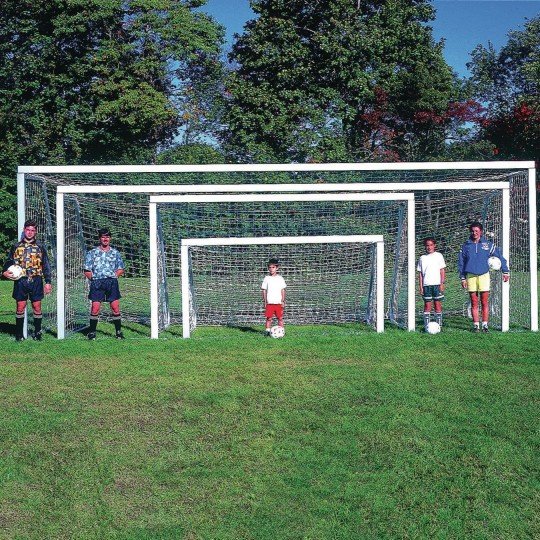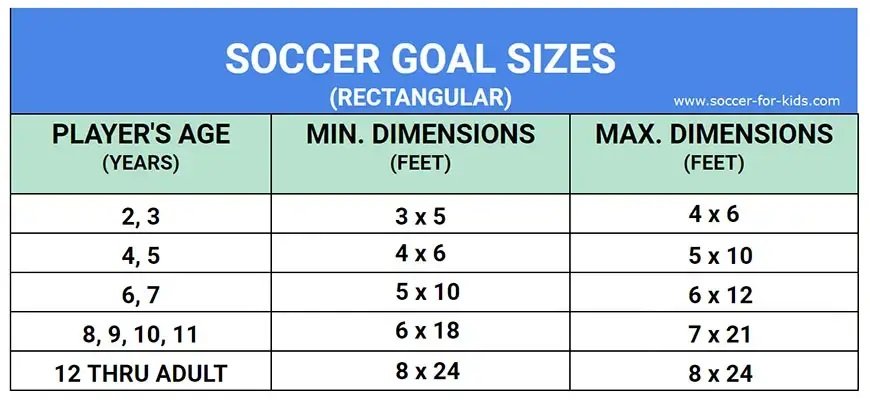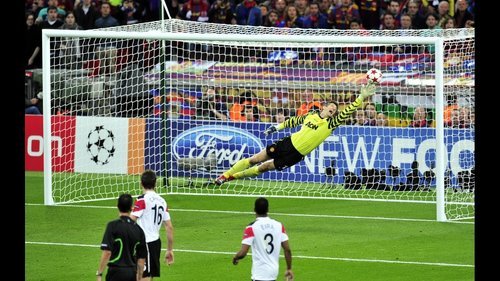- Last Updated -
soccer goal size and dimensions
Soccer, also known as association football, is the world’s most popular sport. It is played by millions of people worldwide and has a rich history that spans centuries. Its origins can be traced back to ancient civilizations such as China, Greece, and Rome, where similar ball games were played for entertainment.
Today, soccer is a global phenomenon with professional leagues in every corner of the globe. One of the key elements that make soccer such an exciting and engaging sport is the goal.
The goal represents the ultimate objective for both teams – to score more goals than their opponent by getting the ball past the opposing goalkeeper and into their net. However, not all goals are created equal, which brings us to our topic – soccer goal size and dimensions.

Brief History of Soccer
Soccer has been played in various forms throughout history with records dating back as far as 2500 BC in Ancient China where they played a game called Cuju which means “kickball”.
Over time, different variations of ball games began to emerge across Europe during the Middle Ages. It wasn’t until 1863 that England established rules for Association Football which became known as modern-day soccer.
The first official international match was played between Scotland and England on November 30th, 1872 at West of Scotland Cricket Club’s ground at Hamilton Crescent in Glasgow where it ended in a 0-0 draw.
Since then soccer has grown exponentially becoming one of the most popular sports worldwide with major tournaments such as the FIFA World Cup drawing billions of viewers each tournament.
Importance of Soccer Goal Size and Dimensions
The size and dimensions of a soccer goal are crucial factors that affect how players approach matches both offensively and defensively. A well-designed goal ensures that skillful players will have an advantage over less skilled ones, while also ensuring that protecting the goal remains a challenge for the goalkeeper and defenders.
Standard goal sizes and dimensions are set by FIFA (Fédération Internationale de Football Association) and must be adhered to in official matches. This ensures consistency in the game, allowing players to practice under consistent conditions and allowing fans to appreciate the beauty of the game without distractions or alterations to goal dimensions.

Purpose of the Article
The purpose of this article is to provide an in-depth understanding of soccer goal size and dimensions. We will examine standard sizes used in professional leagues, variations used for different age groups, climate considerations that impact goal size, and much more.
By understanding how soccer goals are designed, players can improve their skills while spectators can appreciate the intricacies of this beautiful game.
Standard Soccer Goal Size and Dimensions
FIFA Regulations on Goal Size and Dimensions
The Fédération Internationale de Football Association (FIFA) is the international governing body of soccer. FIFA sets the rules for soccer, including the regulations for goal size and dimensions. According to FIFA regulations, a standard soccer goal measures 8 feet in height and 24 feet in width.
The goalposts are located on each end of the field, with a net attached to them that hangs down to ground level. The net must be securely fastened to the posts and crossbar.
Measurements of a Standard Soccer Goal
A standard soccer goal has several parts that make up its measurements. The two vertical goalposts are set 8 yards apart, which equals 24 feet. These posts are connected by a horizontal crossbar that is positioned 8 feet above the ground.
The distance from the ground to the top of the crossbar is also 8 feet. The net is an integral part of a soccer goal’s dimensions as well: it should be at least five yards behind (or inside) each post, so as not to interfere with play around or within each penalty area when touched by players or officials.
Importance of Adhering to Standard Sizes and Dimensions
Adhering to standard sizes and dimensions ensures consistency across all levels of play – whether it’s youth or professional leagues in different countries – providing everyone with an equal opportunity at mastering their skills under uniform conditions.
Another benefit of following standardized dimensions is that it makes it easier for referees when making decisions during games – they can easily determine if a ball has crossed into goals even if they’re standing far away from it.
Adherence to standardized sizes and dimensions ensures fairness in competition between teams while providing opportunities for improvement across all levels with consistent conditions.

Variations in Soccer Goal Sizes and Dimensions
Different sizes for different age groups
Soccer goals are not one size fits all. Depending on the age range of players, there are different size regulations to ensure player safety and an appropriate level of skill development.
Youth leagues typically use small-sided fields with smaller goals. According to US Youth Soccer, for ages 6-8, the goal size should be 6.5 feet by 18 feet.
For ages 9-10, the goal size should be 7 feet by 21 feet. And for ages 11 and up, the goal size should be a regulation-sized 8 feet by 24 feet.
Variations in professional leagues around the world
While FIFA regulations outline a standard goal size of 8 feet by 24 feet, some professional leagues have variations in their regulations that allow for slightly different sizes.
For example, Major League Soccer (MLS) mandates goalposts no less than five inches in diameter but no more than five and a half inches in diameter making them thicker than those approved under FIFA laws which specify post thickness between four and five inches.
In Europe, The Premier League is known for having larger goals compared to other professional soccer leagues around the world.
The Premier League’s regulation-sized goals measure at least eight yards wide (24ft) and eight feet tall (8ft), while other leagues require only seven-yard-wide (21ft) goals.
Unique goal sizes in non-traditional soccer settings
In some cases, unique soccer field dimensions require unique soccer goal sizes as well. Beach soccer is one such example where smaller goals are used due to space limitations on sand-based fields. Beach soccer goals measure just over half the height of traditional football posts at just five-foot high by ten-foot-wide.
Another unique setting is futsal, a variation of indoor soccer that is played on a hard court with smaller goals. Futsal goals are typically 6 feet by 10 feet, around two-thirds the size of traditional soccer goals.
Understanding the variations in soccer goal sizes and dimensions is important to ensure player safety and appropriate skill development at different age ranges.
Professional leagues around the world may have slightly different regulations for goal sizes, and non-traditional soccer settings like beach soccer and futsal require unique goal sizes to accommodate their specific field dimensions.
Factors that Affect Goal Size and Dimensions
Climate Considerations: Size and Material
When it comes to soccer goal size and dimensions, climate can play a significant role in determining the best size to use. In colder climates, smaller goals are often used to make it more difficult for the goalkeeper to cover the entire goal area. The balls used in colder climates also tend to be denser and heavier, requiring more effort to shoot or pass accurately.
In warmer climates, larger goals are often used due to lighter, less dense balls and improved visibility for players. The material used in constructing the soccer goalposts can also affect the decision on what size is best for certain climates.
Aluminum is commonly used due to its lightweight nature. However, it may not be strong enough or durable enough for areas with strong winds or extreme temperatures.
Steel is more durable but heavier than aluminum. Thus, it can work better in areas with less wind but may prove too heavy for transportation purposes.
Field Size Restrictions: Adjusting Goal Sizes Accordingly
Soccer fields come in all shapes and sizes depending on whether they are professional or amateur fields or indoor versus outdoor environments. Field size restrictions can impact the choice of soccer goal size as well as dimensions.
If a field is too small, then smaller-sized soccer goals will need to be used so as not to impede play. Indoor facilities also have tighter space constraints than outdoor fields which means that choosing smaller-sized goals will encourage faster-paced action during games where larger goals might lead players towards defensive strategies that slow down gameplay.
Player Skill Levels: Balancing Challenge with Success
Another factor affecting soccer goal sizes and dimensions is player skill level. Younger players who are just starting may need smaller goals because their strength levels aren’t yet adequate to make shots from a regulation-sized goal.
In contrast, professional leagues use full-sized goals but often adjust dimensions to make the game more challenging and interesting. Ultimately, the key is to find a balance between challenging players without setting them up for failure.
If a player cannot consistently make shots at a particular goal size or dimension, then it should be adjusted to ensure that success is achievable. Conversely, if players become too comfortable with a certain size or dimension, it could lead to reduced competitiveness and lackluster gameplay.

The Impact of Goal Size on the Game
Scoring Frequency and Difficulty
The size of a soccer goal has a notable impact on the scoring frequency and difficulty of a game. Smaller goals tend to result in fewer goals scored per game, while larger goals see an increase in scoring opportunities. This is because larger goals offer more space for players to aim at, giving attackers an advantage over defenders.
However, despite the increased number of opportunities, larger goals also require more skill from players when it comes to finishing. In contrast, smaller goals provide fewer opportunities to score but require a higher level of accuracy from the player since they need to place their shots with precision.
The increased difficulty of shooting accurately in smaller goals can put heavy emphasis on set pieces such as corners or free-kicks. Overall, both small and large goal sizes impact how teams approach games tactically.
The Role of Goalkeeper Skills in Relation to Goal Size
The size of a goal plays a vital role when it comes to goalkeeper skills. A larger goal means that keepers have more ground to cover compared to smaller ones which inherently result in different approaches taken by keepers depending on the size of their goalposts.
For instance, with a bigger target area available for attackers, keepers must have lightning-fast reactions and be able to close down space quickly.
On the other hand, small-sized goals allow for less time for keepers when facing shots from attackers who can shoot at them from closer ranges than they would if there was more real estate behind them between post-to-post. As such, goalkeepers playing with smaller-sized posts typically maintain higher levels of awareness and agility as well as being technically sound with diving skills.
Strategies Employed by Teams Based on Goal Size
Soccer teams often employ specific strategies based on the size of their opponent’s goals. Teams playing with smaller goals may focus more on playing defensively to frustrate their opponents and limit their scoring opportunities.
Teams playing with larger goals often adopt an attacking approach, taking advantage of the extra space available to create chances and score goals.
Some teams may also adjust their formation based on the size of the goalposts. Teams playing with larger goals may choose to play a more attacking formation such as 4-3-3 or 3-5-2, while teams playing with smaller goals might opt for a more defensive-minded formation such as 5-4-1 or 4-5-1.
In addition, corner kicks and set pieces are often used to great effect in both small and large goal games, employing different tactics depending on the goal size. Soccer goal size plays a significant role in how games are played tactically, with varying effects on scoring frequency and difficulty as well as influencing goalkeeper skills development.
The differences between small and large-sized posts require different approaches by players depending upon which they are playing on any given day.
Soccer coaches must take into account these variations when choosing which strategies are best suited for their team’s play style to succeed in varying game conditions dictated by differing pitch sizes.
Conclusion
Summary of Key Points Discussed
Throughout this article, we have explored the different sizes and dimensions of soccer goals and their impact on the game. We started by discussing the standard sizes set by FIFA regulations, as well as different variations used in various leagues, age groups, and unique settings.
We then analyzed the factors that affect goal size and dimensions such as climate considerations, field size restrictions, and skill levels of players, and how these factors affect the game. We have also discussed how goal sizes impact scoring frequency and difficulty, goalkeeper skills in relation to goal size, and strategies employed by teams based on goal size.
The Importance of Understanding the Impact that Goals Have on the Game
Understanding the impact of soccer goals on the game is crucial for players, coaches, referees, and spectators alike. Knowing how different variations in goal sizes can affect gameplay creates a level playing field for all involved parties.
Understanding how goals’ dimensions can influence scoring frequency or difficulty directly impacts tactical decisions made while playing or coaching.
Moreover, recognizing that there are varying factors at play when it comes to determining a soccer goal’s size helps individuals understand that there is no one-size-fits-all approach to this aspect of soccer gameplay. Instead, it requires flexibility depending on context.
Future Developments in Soccer Goal Technology
While much has been written about traditional soccer goals’ sizing and dimensions over time—our focus here—we must not forget about potential advancements in technology shaping future ones’ design. One specific area currently being explored is incorporating sensors into soccer nets to detect when they are scored upon accurately.
Another possible innovation could be related to collapsible nets or modular designs making them easy to set up anywhere needed without inconvenient transportation processes required by traditional fixed structures.
Understanding different types of soccer goals available can help increase the level of play, develop better game strategies, and create fair gaming environments.
While technology is continually advancing, the need for standardized goal sizes and dimensions remains relevant. Soccer goals are more than just a place to score goals; they are an essential part of the game that should be given serious consideration by everyone involved in soccer’s world. (1)
FAQs - Soccer Goal Demensions
History of Soccer and Its Goals:
Soccer, known as association football, has ancient origins dating back to civilizations like China, Greece, and Rome. The modern version of soccer, with established rules, originated in England in 1863.
Importance of Soccer Goal Size:
The dimensions of soccer goals significantly influence players’ offensive and defensive strategies. FIFA sets standard goal sizes to ensure consistency in the game globally.
Standard Soccer Goal Dimensions:
FIFA regulations stipulate that a standard soccer goal is 8 feet high and 24 feet wide. The net is an integral part of the goal’s structure.
Goal Size Variations for Different Ages: Soccer goals vary in size for different age groups. For instance, goals for ages 6-8 are typically 6.5 feet by 18 feet, while regulation size for ages 11 and up is 8 feet by 24 feet.
Professional League Variations:
Some professional leagues have slight variations in goal sizes. For example, MLS uses thicker goalposts than FIFA regulations, and the Premier League has larger goals compared to other leagues.
Unique Goal Sizes in Special Soccer Settings: Beach soccer and futsal, for example, use smaller goals due to their specific field dimensions and gameplay requirements.
Climate and Material Considerations:
The size and material of goals can vary based on climate conditions. For example, smaller goals in colder climates and larger goals in warmer climates. Materials like aluminum and steel are chosen based on their suitability for different weather conditions.
Field Size Impact on Goal Dimensions:
The size of soccer fields, whether they are professional, amateur, indoor, or outdoor, affects the size of the goals used.
Player Skill Level and Goal Size:
Younger or less skilled players might use smaller goals, whereas professional leagues adjust goal dimensions for more challenge and interest.
Impact of Goal Size on Game Dynamics:
Goal size influences scoring frequency and game difficulty. Larger goals lead to more scoring opportunities but require greater skill in finishing. Conversely, smaller goals demand higher accuracy.
Goalkeeper Skills in Relation to Goal Size:
Goal size dictates the goalkeeper’s approach, with larger goals requiring faster reactions and more agility.
Team Strategies Based on Goal Size:
Teams adapt their strategies based on the goal size they are playing with, often choosing different formations and tactics.
Importance of Understanding Goal Impact:
It’s essential for players, coaches, referees, and spectators to understand how goal sizes affect the game, influencing gameplay and tactical decisions.
Concussion Substitutions in Soccer: evolving concussion protocols
The Growing Concern for Player Safety in Soccer Soccer, a beloved sport...
Read MoreThe Historical Dominance of Brazilian Soccer in the World Cup
Introduction: The Beautiful Game's Grandest Stage The World Cup, a grand tournament...
Read MoreBox-to-Box Center Midfielder: The Engine of Modern Soccer Teams
Soccer is a game of skill, strategy, and teamwork. Every player has...
Read MoreSoccer Substitution Rules: The Strategic Art of Changing the Game
Soccer, known as the beautiful game worldwide, has seen various changes to...
Read More


















